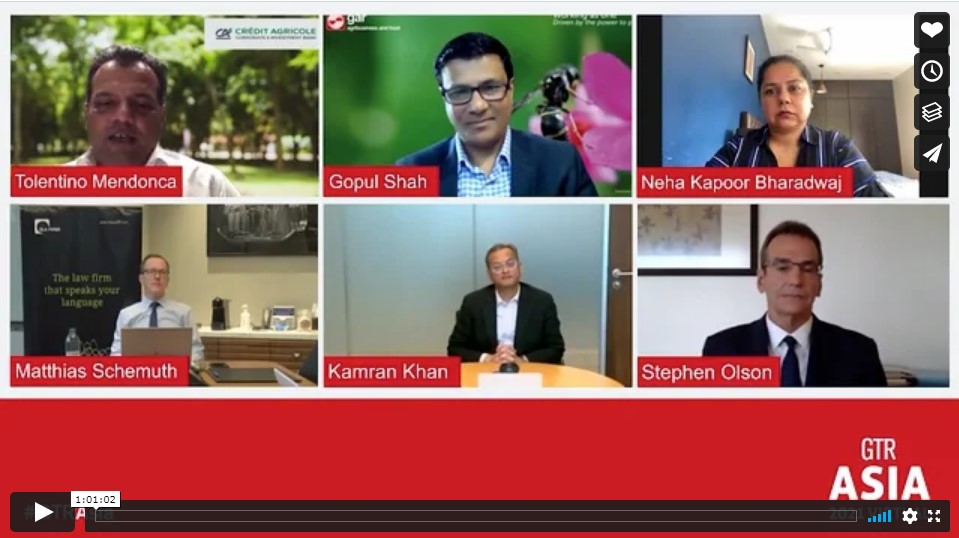19 January 2022
With Asia proving the most resilient component of the world’s economic engine during the pandemic, can it maintain trade-led growth that accommodates economic, social and governance (ESG) considerations? flow reviews GTR Asia’s recent virtual conference that considered this issue
MINUTES min read
The impact of supply chains, the role of finance as leverage in establishing ESG as a priority, the risk of ‘greenwashing’, and the need to define universal metrics that measure companies’ ESG progress and their accountability to stakeholders all came under the spotlight in GTR Asia’s most recent virtual conference.
Entitled Trade-led growth and ESG – can Asia strike the right balance? the event took place at the end of November and moderator Tolentino Mendonca, Regional Head of Trade Finance for Asia Pacific at Credit Agricole CIB, Singapore posed the question to a panel of the following five professionals:
- Kamran Khan, Head of ESG for Asia Pacific, Deutsche Bank
- Stephen Olson, Senior Research fellow of the Hinrich Foundation
- Gopul Shah, Director and Head of Trade Finance, Golden Agri Resources
- Neha Kapoor Bharadwaj, Corporate Social Responsibility (CSR) Lead, Bank of America, India
- Matthias Schemuth, Head of Finance & Projects, Restructuring - Asia, DLA Piper

Screenshot of GTR Asia panellists (source: GTR)
Collaboration is key
Stephen Olson of the Hinrich Foundation opened the session. The Foundation, an Asia-based philanthropic organisation to advance sustainability in global trade, publishes the sustainable trade index (STI), which assesses the extent to which international trade not only generates balanced economic growth, but also strengthens social capital and encourages economic stewardship.
“A key message of the STI is that foreign direct investment (FDI) will play a critical role,” explained Olson. “Governments cannot meet their sustainability commitments and aspirations alone; particularly their sustainability development goals (SDGs). Many have been remarkably transparent in stating they’ll need private sector partnerships to get things done.” Therefore, he stated, “it’s clear that responsible and mutually beneficial FDI will represent a critical piece of the jigsaw”.
This message that collaboration is key was echoed by Gopul Shah, Director Treasury and Head of Trade Structured Finance at Singapore-based palm oil supplier Golden Agri-Resources, who said that blazing forest fires and “garbage all around us” evidenced the environmental price of decades marked by strong economic growth. He expects the focus to shift “towards us all working together to improve our environment by managing climate change, working to decarbonise and ensuring that the structure of our society improves both at the corporate and governmental level”.
According to him, the pandemic has accelerated this change in two ways: by showing that there is only one world thus requiring a global effort, and by driving the implementation of new technologies and tools which could help achieving a new balance between growth and climate change going forward.
ESG reporting standards are just kicking off
Focusing on the growing importance of ESG as an asset class within trade finance, Mendoca then invited Matthias Schemuth, Head of Finance & Projects, Restructuring – Asia, at law firm DLA Piper to outline how banks and corporates are embedding ESG within their legal documentation. Schemuth noted that green and sustainability-linked bond transactions have been booming across Asia1, but he also mentioned two challenges. First, producing ESG-compliant documentation – particularly the independent attestation that attached to it – would also push up costs. Second, for industries that are not “green” by definition, but must transform their business models, attracting capital “tends to be harder”. According to him, these industries require more testing and monitoring of their sustainability performance than for example the renewable sector does.
At the same time, there has been good progress in encouraging higher standards for legal documentation and certification, Schemuth reported. In 2018, the Loan Market Association (LMA) Asian Pacific Loan Market Association (APLMA) and the Loan Syndications and Trading Association (LSTA) developed the Green Loan Principles2, which more recently were joined by the Sustainability Linked Loan (SLL) Principles3. However, those standards, are not legally binding, as Schemuth points out, “but rather are self-imposed rules and regulations to ensure that a transaction meets criteria that are widely accepted in the market”.
Yet, with regards to accounting and reporting on sustainability “we are still very much in the development stage,” said Schemuth. Jurisdictions in Asia would start to lean towards the EU Taxonomy, he observed, with China “adopting many of its principles”, while the monetary authorities of Singapore and Hong Kong would also take steps towards standardisation in reporting.
COP26 mood music
Panellist Kamran Khan, Deutsche Bank’s Head of ESG for Asia Pacific, was able to report on the mood music at COP26 as a delegate at the Glasgow summit, but first noted the Bank’s rapid progress since May 2020 when it announced a target of facilitating €200bn in ESG financing by 20254. After only six months, that deadline was advanced to 2023 and subsequently a figure of €125bn had already been reached by the end of Q3 20215.
“Asia is the sourcing capital for almost all global supply chains”
So, how does Asia fit into the sustainability picture? According to Khan, “Asia is at the heart of all of this,” he said, recalling his experience from COP26 where “seventy to eighty percent of my discussions” were “about the role of Asia in this ESG debate”.
According to him this is because “Asia is the sourcing capital for almost all global supply chains”, although the majority of the Bank’s clients are multinational MNCs and many of those have their head offices in Europe or North America. This is why they have “the least visibility” around how their businesses are “impacting on the local economy, the local social fabric and the environment” in Asia. “It is our job to help them provide clarity on what their businesses are doing in Asia and in other emerging markets,” Khan said.
However, the rules applicable in Europe – or increasingly those of the US – could not simply be cut and pasted to apply in Asia, Khan stated. The task for Deutsche Bank and other global banks “is to be able to understand the rules and the materiality of what those standards mean; how they can be applied to on-the-ground realities in Asia; and to have the gumption to ask our clients and our own teams to provide the evidence and data to substantiate their ESG claims”, he said.
“It’s why we set up our ESG centre of excellence here in Singapore and not New York, London or Frankfurt. If we can get this right in Asia, then it stands to reason that it will be a relatively simple task in getting it right for other jurisdictions.”
Ambition versus reality
Moving to the ambitions of COP26, Khan said that the inability to achieve a unanimous commitment at the summit from all countries to commit to a target of 1.5°C maximum in limiting the rise in global temperatures had disappointed many. “But what saved the day was the sovereigns saying that next year they can come back and increase their targets and perhaps then catch up with the 1.5°C goal. It doesn’t mean that they’ll get it, but at least it keeps the hope alive”.
Khan said that the issue of carbon trading – and whether it served just as a panacea or a model to be adopted globally – was also to the fore at the summit. Encouragingly, governments had committed to enact legislation to encourage carbon trades. “That’s very good news, as it means that work will be done to define standards – particularly on the quality of and accounting of carbon credits. We’re now moving forward and once there’s an agreement that this is a tool we’re going to be using, the experts can work out just how we’re going to use it properly”.
At the same time, he stressed that carbon trading is only one component of corporate ESG strategy – it should be accompanied by moving the asset portfolio towards greater sustainability; applying mindset and capital towards improving operational performance; and incentivising partners to share ESG goals.
Can ECAs deliver?
During the Q&A session that followed individual presentations, Khan addressed the question of why the phasing out of coal is not accelerated; suggesting that for many developing countries the social impact of a ban on coal would be excessive as many communities are ill-equipped to bear the shock. Yet, the good news would be that in many markets around the world the “price of renewable is already at – and in many cases below – coal pricing”, with India a prime example.
Commenting on the question whether export credit agencies (ECAs) are offering enough support for new companies leading the transition away from oil and gas, Khan felt that ECAs lacked the staff and the internal frameworks to structure complex deals. “At the end of the day even the EU Taxonomy does not provide details of every type of transaction – and certainly not in Asia,” said Khan. “So as a banker, you must know the regional environment, the sustainability materiality and then be able to structure the transaction, very aptly to be able to provide a solution. Even the biggest ECAs in developed economies would be hard pressed to do that.”
GTR Asia’s virtual conference Trade-led growth and ESG – can Asia strike the right balance? was held on 30 November 2021
Sources
1 See https://reut.rs/352ywVN at reuters.com
2 See https://bit.ly/3I9qngm at lma.eu.com
3 See https://bit.ly/3A7pYbw at lma.eu.com
4 See https://bit.ly/32cduTy at db.com
5 See https://bit.ly/33lOB8F at db.com
Trade finance solutions Explore more
Find out more about our Trade finance solutions
solutions
Stay up-to-date with
Sign-up flow newsbites
Choose your preferred banking topics and we will send you updated emails based on your selection
Sign-up Sign-upSubscribe Subscribe to our magazine
flow magazine is published annually and can be read online and delivered to your door in print
You might be interested in
TRADE FINANCE, SUSTAINABLE FINANCE
Driving ESG initiatives through sustainable finance Driving ESG initiatives through sustainable finance
Greening the supply chain is a trend to enhance competitiveness, says Deutsche Bank’s Rachel Chia, Head of Project Finance, Renewables (Asia Pacific) in a recent interview with The Asset’s Chito Santiago. flow shares her insights
TRADE FINANCE, SUSTAINABLE FINANCE
New face of trade New face of trade
Trade economist Rebecca Harding examines how Covid-induced patterns of shifting work and consumption have increased supply chain scrutiny and highlighted critical export flows
Sustainable Finance, Regulation
More Treasurers are facing key ESG challenges
Meeting the growing list of environmental, social and governance (ESG) requirements is having a greater impact than any other treasury issue, a new survey by Economist Impact reveals. flow’s Desirée Buchholz reports why regulation is a double-edged sword for companies – and what could ease the burden



